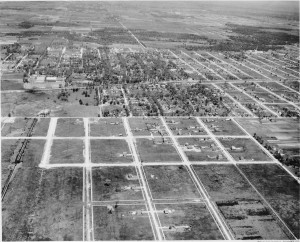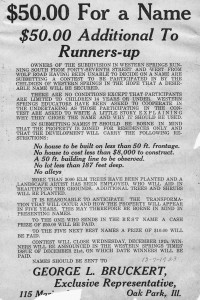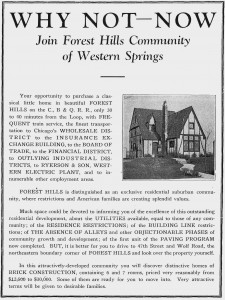Residents of Western Springs’ Forest Hills subdivision are justly proud of their neighborhood. But, it was a long time coming.

Forest Hills from 51st Street looking north – circa 1925
In 1923, George Bruckert, a realtor and developer, envisioned a community of fine homes south of 47th Street and west of Wolf Road. Central to his plan were large lots (a minimum of 187 feet deep) and relatively expensive homes (a minimum of $8,000).
After purchasing the land and laying out streets, Bruckert faced a major question as to what the area should be called. The answer was supposed to come from a naming contest. The first prize would be $50, with $10 paid to the five runners-up.
Unfortunately, while winners were chosen and paid, the contest did not produce the final name. In fact, the developers were initially planning to use “Fair Elms” as the name, which was derived from the two entries of “Fair View Gardens” and “Elms.” It appears that the developers decided instead to use the name of Forest Hills-based on the fashionable and attractive town on Long Island, New York. However, the name “Fair Elms” would be used to name the western-most street in the development.
Ironically, one early resident remembered that, when he was a boy, there were no “hills” and only the only “forest” consisted of two weeping willows near Flag Creek. He also recalled watching “… a village employee planting elm seedlings every 30 feet or so down the parkways of imaginary streets.”

“Name the Subdivision” Contest – 1923

Forest Hills ad – circa 1928
The new Forest Hills initially developed very slowly. During the first five years, only 42 homes were built and occupied. Part of this was no doubt the result of unpaved streets and the area’s decidedly rural appearance. Muddy ruts served as streets. And, a news article from 1929 reminded residents to be careful after November 10, which was the start of the hunting season. It seems the tall grasses at the south end of Forest Hills provided a haven for wild pheasants, which attracted hunters. But, efforts to market the area accentuated the positive.
In 1928 and 1929, the first paved streets and curbs were installed. But, since the cost-conscious developers were responsible for constructing the streets, very few east-west streets were paved, something which was never fully addressed. In 1932, the now-familiar “Forest Hills” street signs were added at key entrances to the subdivision.
During these early years, street flooding was a frequent occurrence due to the lack of a good sewer system, as well as the whims of nearby Flag Creek. For many years, residents (especially at the south end of the subdivision) lobbied for new streets and sewers. But, other residents opposed them because it would require a costly, special assessment. They would not be installed until the 1960s. This, plus the Tollway’s modifications to Flag Creek, was instrumental in controlling the flooding problem.
